September Newsletter
Volume 1, Issue 8
September 1, 2020
Special Points of interest

State Director of Instruction
Welcome to the September issue of the MRC newsletter. We hope all of you and your family and friends are staying safe.
August was a busy month for the MRC. As you may know, our referee registration year begins in July. But because of the pandemic and other difficulties, the process has been delayed. Nonetheless, the MRC members have had virtual meetings several times a week (and some times a few times every day) to launch the grassroots referee course and the grassroots referee recertification course as soon as possible.
While we worked on referee courses, we also worked closely with mentors. All current instructors and assessors were invited to attend a training session in mid-August. In the meeting, we covered the most recent Laws of the Game changes that will take into effect in January 2021 in Michigan. All mentors that participated in the meeting have a copy of presentation slides that they can use to teach a session on the law changes. In addition, all of them received a four set of instructional slides, each of which covering challenges, offside, tactical fouls, and handling. I have communicated with these mentors that they should seek opportunities to teach referees in their own respective area. If you are a referee reading this newsletter who wants to learn more about these topics, please reach out to your local mentor or your District Directors of Referee Development. I encourage these instructional sessions beyond what the MRC offers and beyond the scope of annual recertification clinics. You can learn more about the mentor meeting below.
As always, our September newsletter is full of exciting stories and information. We will start with Mr. Steve Olson’s interview. He is not only a former FIFA assistant referee, a national referee coach, and PRO assessor, but also the Chief Operating Officer of the National Sports Center, in Blaine, MN. This is the sport complex where the largest youth tournament in the world, Target USA Cup, is held every July. Some of you might have attended the tournament as a player and/or as a referee. Although the tournament was canceled this year, it is scheduled to take place in July 2021. Please visit this website to learn more about the tournament.
Our regular content includes Referees of the Month and Who’s Who. We are featuring Wayne and Bill Wilkinson for the Referees of the Month column. We have John Nadzam for Who’s Who. Both Ken Wikle and Ryan Homik have their columns.
We have some technical information. Nick Balcer talks about pregame. In his interview, you will learn some of the best practices that he recommends. But he also recognizes that when many of us referee, we only have 5 or 10 minutes between games. He has some advice on how to have an effective pregame when there is very little time. Nicole Green continues to write about how to assess the severity of an offence.
Recently, Mr. Luke LaMere, a grassroots referee from the west side of the state, interviewed me for his class project. He is a student at University of Michigan. He has turned his interview in a podcast. You can listen to his podcast here.
Beyond this newsletter, please be sure to follow our Twitter (@MichiganReferee) and subscribe to our YouTube Channel.
Inside this issue
Michigan Referees Beyond Michigan: Steve Olson
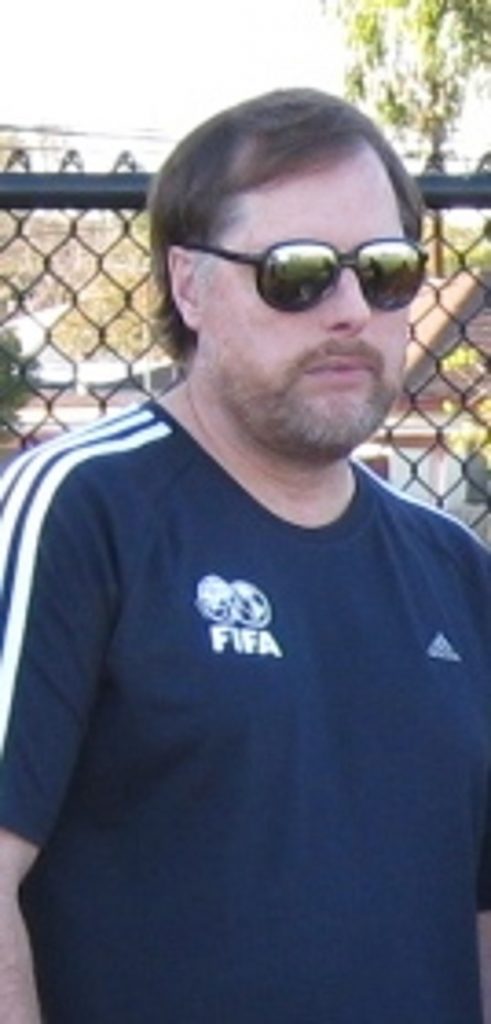
Former FIFA Assistant Referee, PRO Assessor, National Referee Coach
For the September newsletter, we had the honor to interview Mr. Steve Olson. He is a former FIFA Assistant Referee. He is also the Chief Operating Officer at National Sports Center in Blaine, MN.
What is your relationship to Michigan? How long did you live in MI?
I was born and raised in Flint and went to college in Ann Arbor.
What do you miss the most about MI?
The scenery and the good swimming lakes.
Do you have any referee or soccer-related memories from MI?
I did my first ever game in the Mott Soccer League in Flint. It was a really large league for the early 1970s and there were several high-level referees who came out of Flint. Bill Scofield (a U.S. Soccer award is named after him), Gerhard Mengel (the National Amateur Cup is named after him), Dave Sutton, Doug Burroughs (probably better known as the long-time head coach at Grand Blanc High School), and my brother Eric all worked in the Mott League. All were very successful high school, college, and amateur league referees for several years. My first International A match was at the Pontiac Silverdome. I was also the field producer (now known as the fifth official) for the four World Cup games in Pontiac in 1994. I got to work with the referee who did the final and the referee from France who was considered the top ref in the world at the time.
What are your current referee-related responsibilities/roles/appointments like?
I am a national referee coach and one of the thirty or so assessors with PRO working MLS games.
What is the best memory of your referee career?
Obviously, the promotion to the international panel of assistant referees was one of the top memories and so were the two MLS finals. Working a college game with Harry Keough as my fourth official is another. Another memory that I will never forget is my last game at Youth Regionals, the U-14 girls final as the fourth official.
What is the best memory of your referee career as an administrator in the referee world?
I was the first referee director elected to the U.S. Soccer National Board of Directors in 1998. I had several talks with the Coaching Director at that time, Bob Gansler, about the status of the coaching program. He was fighting an uphill battle of funding and informational management. Many of the same issues existed with the referee program, and the referee program had devised a working plan. It made me appreciate how well run the referee program was. My position on the Board of Directors also put me on the National Referee Committee and I had the privilege of being able to vote for Kari Seitz for a FIFA Referee appointment. We were confident in that decision but had no idea how she would rewrite history as a referee.
What are a few of the things that helped you become a successful referee?
Having mentors and listening to them. I had to work really hard on not over-analyzing situations, feeling things more than thinking about them, and keeping things as simple as possible. Another big thing was learning to control what you could and avoiding things you could never control (like fans). As an assistant referee, learning how to be the best possible “co-pilot.” During the height of the career, I trained at least an hour a day, so fitness was never an issue.
What advice do you have for young aspiring referees?
Listen to your mentors and take advice that works for you. Incorporate the best qualities of your peers, but don’t try to copy them. When the pandemic issues pass, travel to get the best possible games. Choose games that are difficult over games that pay well. Train daily.
Thank you, Steve.
Thank you.
Referee of the Month: Wayne and Bill Wilkinson
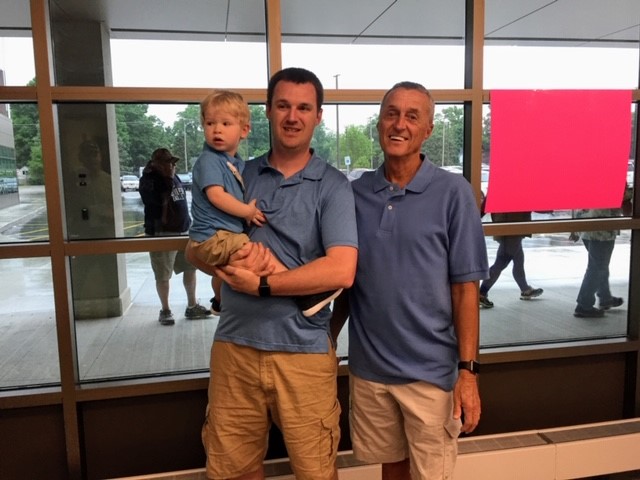
Wayne started as a soccer coach for the Portage Soccer Club when soccer was brand new to the community over 30 years ago. Pat Norman (founding member of the Portage Soccer Club) recruited Wayne to be a soccer coach for Wayne’s daughter Wendy and Pat’s daughter who were classmates when they were 12 years old. Wayne saw that there was such a shortage of officials and he became an AYSO official and coach close to 30 years ago and then moved on to become a USSF official within a couple years. Wayne has now been officiating MHSAA games for close to 25 years and College soccer for 20 years. Wayne says, “I really enjoy working with the kids and also making many long term friends within the referee community. It has really been very special for me getting to work with my son as an official for many years.” Wayne then became the assignor for MHSAA soccer 15 years ago and then the USSF assignor for WMYSA 13 years ago. Wayne is still the assignor for both organizations in the Greater Kalamazoo area.
Billy started officiating at age 13 because his dad was doing AYSO and he thought it was a good way to get some community service hours in for middle school and high school. One year later, Billy realized that he could make money officiating and started officiating USSF. The thing Billy enjoys most about officiating is the comradely among officials and being able to spend more time with his dad.
Wayne and Bill said, “Yes, we still referee games together, mainly high school but some college.” Wayne does not officiate USSF any longer. They both love challenging each other’s knowledge of the Laws of the Game and sharing that night’s war stories. One of the biggest helps for Wayne and Bill was the ability to share game issues and or problems with each other and work out how to not make the same mistake or problem happen again.
Bill also remembers, “Growing up, my sister always played soccer and my dad actually built a soccer field right next to our house for her to play on. I grew up a soccer kid and I really enjoyed playing until I was about 16 years old. Then my passion changed, and I truly fell in love with officiating soccer more than playing.”
When Wayne and Bill are not officiating soccer, they are working on projects around the house or hanging at the beach in South Haven trying to get rid of their referee tans.
Mentor Development Meeting
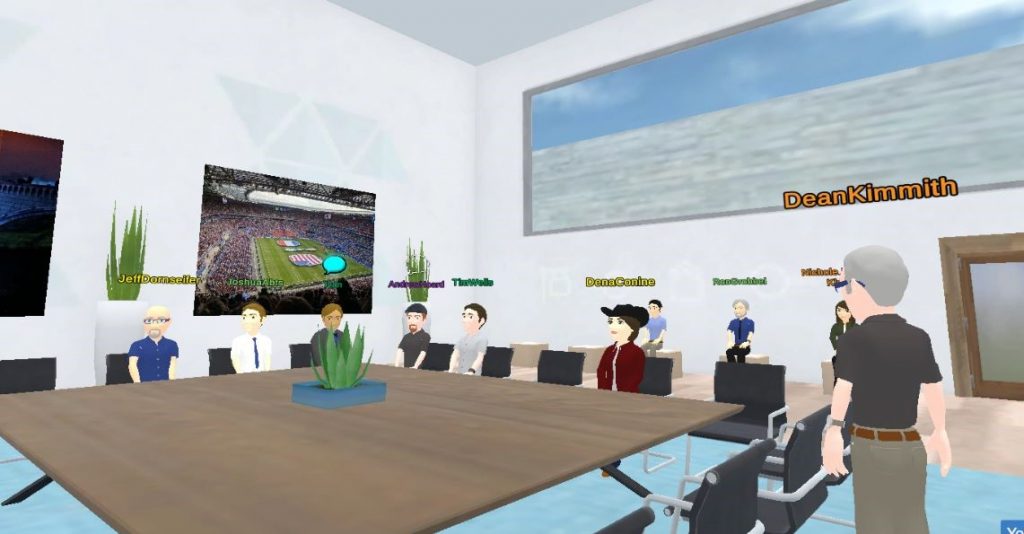
State Director of Instruction / National Referee Coach
On August 19, the Mentor Development Groups met on VirBELA for their monthly training meeting. Group 1 focused on handling. While the grey zone that existed with handling previously became smaller with recent changes, there are many considerations to think about to determine a handling offense. Group 1 mentors were tasked to discuss how best to teach these numerous considerations to grassroots referees. For example, should the class discuss all the considerations at once and watch videos after to determine which considerations were relevant? Or should the class discuss each considerations separately, followed by a clip or two? Most agreed that more experienced grassroots referees would benefit from the first approach and less experienced referees would benefit from the second approach. There also was a discussion about making a flow chart that would help referees figure out if the contact between an arm/hand and the ball is handling.
Group 2 focused on aerial challenges. Sue Grobbel, one of the Group 1 members, was in charge of leading this discussion. Using two video clips, the group explored various consideration points that existed with aerial challenges. I am sure you have wondered, “Did the player undercut his/her opponent? Or did the opponent jump over him/her?” Aerial challenges are not easy to decipher. I hope that the session helped mentors gain a few more tools to discuss such offenses in an effective way during a post-match debrief.
Women’s Referee Academy Meeting
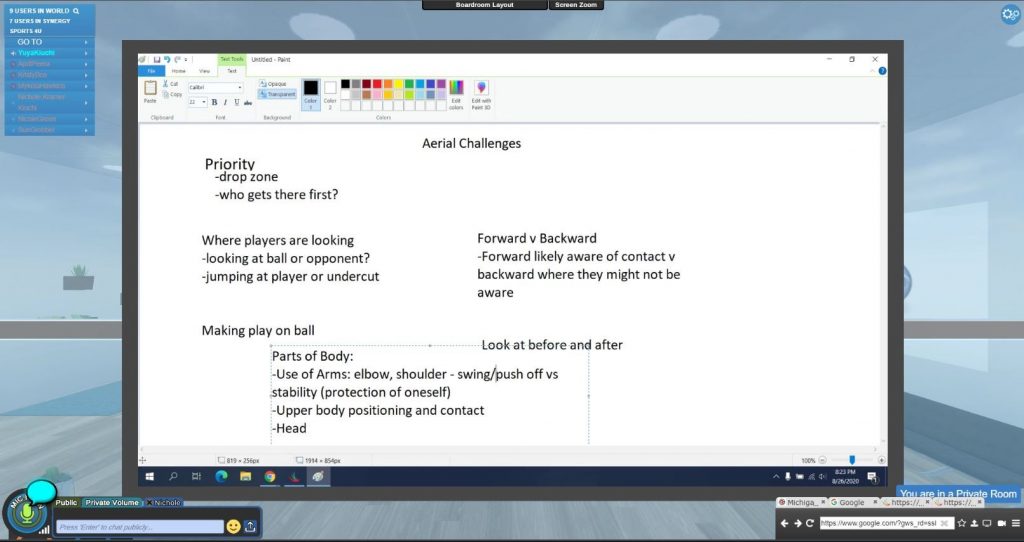
On August 26, the Women’s Referee Academy had its monthly training session. The session was led by Sue Grobbel, Nicole Green, Nichole Kramer-Kiuchi, and Yuya Kiuchi. Like the meeting in July, the academy referees discussed aerial challenges.
The meeting started with a simple question of “What are some of the considerations for aerial challenges?” When you look at the Considerations documents issued by FIFA, you will notice that there is a list of considerations for challenges. But nothing is specific to aerial challenges. Therefore, the participating referees were tasked to create a list of how they evaluated the legality of aerial challenges, as well as how they evaluated a possible misconduct associated with the challenge. Some of the items included the priority to the ball and space, direction of the ball, movement of the players involved, etc.
Once the list was made, referees watched two clips. The first clip was from a USL2 match that Nicole had officiated last year. Having Nicole as one of the instructors allowed the group to learn what went through her mind to evaluate the challenge and how she ended up determining that the challenge was a foul. The other video was from a U-18 State Cup match, a match category familiar to all attending referees. The group discussed how the challenge was fair in relation to the considerations, even though the referee had called it as an offense.
Assessing the Severity of an Offense: Part 3 (Speed + Distance = Force)
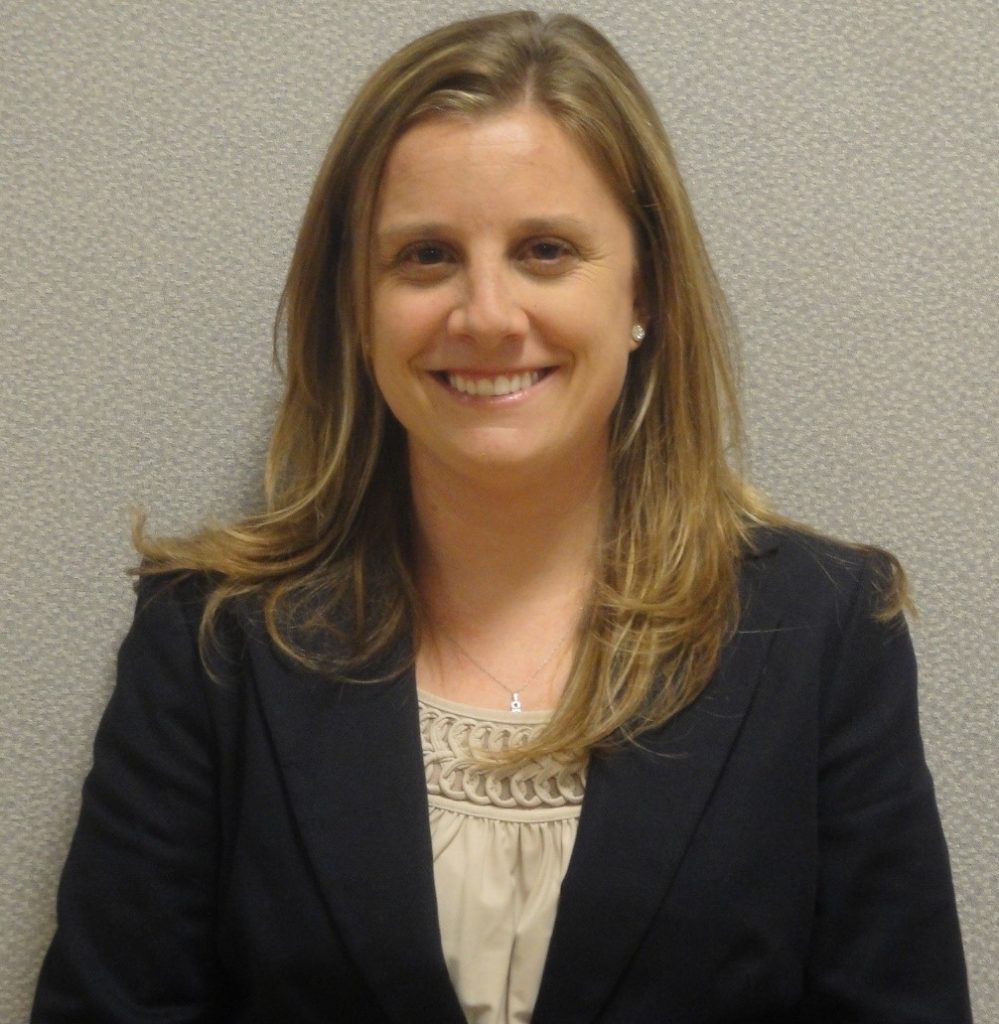
National Referee Candidate
Last month, we introduced the concept of point of contact as a consideration for determining foul severity. Let’s review the two example clips:
Point of Contact of the Perpetrator & Point of Contact of the Victim
Video #1: White player #44 uses the bottom of his cleat/foot to contact Blue player #8 in the thigh/groin. The expected ruling is a foul and red card.
Video #2: Yellow #6 uses the bottom of his cleat/foot to contact Blue #11 on his foot. The expected ruling from FIFA is a foul and red card. Even though the point of contact is low, other factors of consideration are high. The challenge was with cleat studs exposed, straight leg, and high level of force.
Moving on to our new topic for this month and the second consideration to help determine the severity of a foul: Speed + Distance = Force. We should be thinking about a few questions:
- How fast is the player initiating contact running in to approach the challenge to her opponent? Generally, the faster the speed of the player initiating contact the greater the severity.
- From how far away does the player travel before initiating contact? Generally, the greater distance traveled, the greater the severity.
- Speed of the player committing the challenge + Distance traveled of the player committing the challenge = Force of the challenge (or the push/pull of the interaction between the two players)
| Foul | Foul + Yellow | Foul + Red |
| Low Severity | Medium Severity | High Severity |
| Generally, the player initiating contact is moving into the challenge slowly. Also, before contact, the players are already relatively close to one another. | Generally, speed and/or distance are medium severity. | Generally, the player initiating contact is moving with great speed into the challenge. Also, the players start from a great distance apart and the player initiating contact travels many yards before initiating contact. |
Let’s practice this by watching a few video clips:
After watching both plays, please complete this brief quiz. The appropriate decisions will be reviewed in next month’s newsletter.
Who’s Who in Michigan: John Nadzam
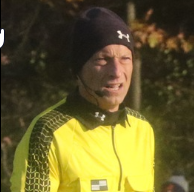
Regional Referee and Referee Mentor
John has been a referee for 27 years. He got his start in AYSO, when no one else was willing to be the referee. From that day in 1993 he has been learning, growing, teaching, mentoring and involved in many areas of soccer. Starting him on this journey were a couple of big influences: Heinz Meyer in the early days, and continuing with Jerry Ouellette. These two gentlemen mentored, molded, and influenced him on managing a soccer match.
Currently, John is a USSF regional referee and referee mentor. He has also been the Kalamazoo District Referee Administrator of officials for many years. Through the years he has been involved in instructing many new officials. He is an active NISOA official. He has officiated in multiple collegiate conferences in Divisions 1-3 and NAIA. He also works matches in the PDL and NPSL. As a MHSAA referee, he has been appointed as the Referee for four State Finals.
One of his most memorable matches was a college match where one team’s trainer forgot to load uniforms for the team. The team had to go to Dicks sporting goods and get outfitted. The coaching staff used white tape for numbers on players jerseys and shorts. The numbers kept falling off and the officiating crew would have the player leave the pitch for not being properly dressed. The officiating team got through the match with minimal altercations. From experience, John knew that after the match he needed to inform the assignor, conference commissioner, etc. what had occurred that night, because the match played had to get played.
When John is not on the soccer field, he can be seen out running, working in the yard, barbequing, and swimming in the pool at his Richland Michigan home. He has been married to his amazing wife Denise for 38 years. They have two children, Tyler and Kelsey, and one grandson Crue. John is employed by Stryker Instruments in Kalamazoo and is currently the Interim Call Center Supervisor. He has been employed at Stryker for 23 years.
Tip of the Month: Pregame

National Assistant Referee
When you meet up with your crew before a game, what do you discuss? What does your pregame entail? If you are the referee, what do you cover? If you are an assistant referee, do you ask questions? This month, we asked Nick Balcer, a national assistant referee, about his experiences and tips about pregames. When he works as a referee, what does he talk about? When he is an assistant referee, what does he do?
In addition, we asked him what advice he had for many of us who only get 5 or 10 minutes before a game when we work on multiple games on a day. I am sure you have had a situation where you run from a field to another and make it to the field only a few minutes before the kickoff. What should you discuss in a minute or two? Check out the interview here.
Referee Goof Ups: Chapter 2

Regional referee first registered with USSF in 1978
This is a follow up to my previous article about mistakes referees make and how to fix them.
Mis-carding a player: You just sent off a player for something that really doesn’t warrant a send-off or you just cautioned a player who should have been sent off.
Although you can change your mind before you restart play, these mistakes in judgment are rarely corrected on the spot. If the game has been restarted they cannot be changed. It is improper to change a card for misconduct on your game report once you have issued it during the match. Do not modify the facts of the game just because you feel bad about your mistake. If you showed a yellow card on the field, it has to be a yellow card in the game report. Explain what happened to cause the card in your report in writing and that your card wasn’t appropriate to the action of the player. Let the competition authorities make a decision as to the punishment meted out to the player. You also want to do some soul searching about how you reacted and why you gave the wrong card. Use it as a learning experience.
Note to ARs: If you see your referee make a serious mistake in judgment or misapply the laws of the game you are obligated to intervene and give your input to the referee before the game is restarted. You may be able to ultimately prevent an injustice or even a protest. The referee may insist in proceeding according to his decision, but at least you offered your input. Most leagues will hear protests involving misapplication of the laws. If the protest is upheld it will be a lesson to the referee.
Carding errors continued: If you carry your cards in the same pocket or mistakenly put the wrong card in the wrong pocket, it is possible to show a red card when you mean to show a yellow. If you make this mistake, correct it immediately, with a loud explanation to everyone in the vicinity that you pulled the wrong color card. Some kind of obvious pantomime indicating the first card is not valid could also send a message to anyone within eyesight. Be prepared to make further explanations at the half or after the game to those who have a need to know. The opponents of the player you supposedly sent off and changed the card to yellow will be disappointed that the other team will not be playing short the rest of the game. They may even accuse you of being partial to this team. This is not a mistake you want to make, so be more careful in your pre-game preparation. This is why many referees carry their red card in their back pocket to make it a little harder to access. This doesn’t mean with this method you couldn’t still get the cards in the wrong pocket. Almost everyone who has refereed for years will admit to doing this at least once. Good pre-game habits are the best prevention for this.
Cautioning a player twice in the same game without showing the red card: Even FIFA referees in the World Cup have made this mistake. Possible causes of this are either inattention or poor record keeping. You must send this player off as soon as you realize your mistake. This is another example where the intervention of an AR or fourth official would be critical This error is not subject to the “match restarted” limitation. Play should not continue any longer than necessary knowing this error exists. If there is a stoppage of play shortly thereafter, use it to show the player the red card and have the player removed before restarting.
There are lots of opportunities for making mistakes. Murphy’s Law is at work all the time. Having good mechanics, help from your ARs, good record keeping habits and concentrating well on your game can prevent a lot of these errors. How you handle these goofs when you correct them can make a huge difference. Hopefully, these tips will give you some help.
The Art of Health
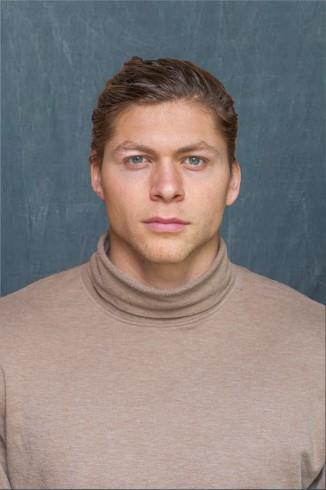
Injuries are no fun, they can slow your progress or completely halt your progress, preventing you from being able to reach your goals. Luckily there are many steps that can be taken to prevent getting injuries. Such aspects as keeping up with your gear, doing proper activities before/after workouts, and having a routine that emphasizes recovery. Click on the link below for more details, and as always feel free to ask me questions!
Ryan’s video on injuries can be found here.
Michigan Referee Committee
State Referee Administrator (SRA): Carlos Folino
State Referee Chairman (SRC): James Wheeler
State Youth Referee Administrator (SYRA): Ronald Grobbel
State Director of Assessment (SDA): Dean Kimmith
State Director of Assignors (SDoA): John Corbett
State Director of Instruction (SDI): Yuya Kiuchi
State Director of Futsal (SDF): Richard Gilbert
Email addresses are the title in parenthesis plus @michiganrefs.org
Please reach out to us!
If you have any referee-related stories to share or someone you think should be featured in this newsletter, please reach out to us at sdi@michiganrefs.org.
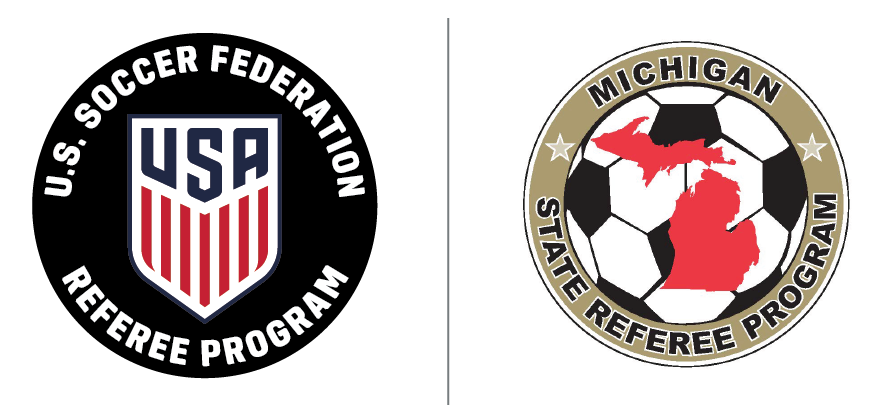
MRC announcements
As of the launch of this newsletter, we do not have any matches sanctioned by Michigan Soccer Association or Michigan Stat Youth Soccer Association scheduled. Those who have recertified for this year should have received an email stating that your referee certification had been extended by a year. Although you will still have to participate in the referee recertification training administered by the U.S. Soccer and/or Michigan Referee Committee to be able to officiate in 2021, your certification has been extended for free. If you did not recertify for 2020 or if you are a brand-new referee, you will have to pay the registration fee.
We are in the final stage of establishing the grassroots referee course for brand-new referees and the grassroots recertification courses. You can expect an email from us about opportunities to take a course to be eligible to officiate in 2021.
As always, please check out the MRC website for the latest information on COVID-19 updates.


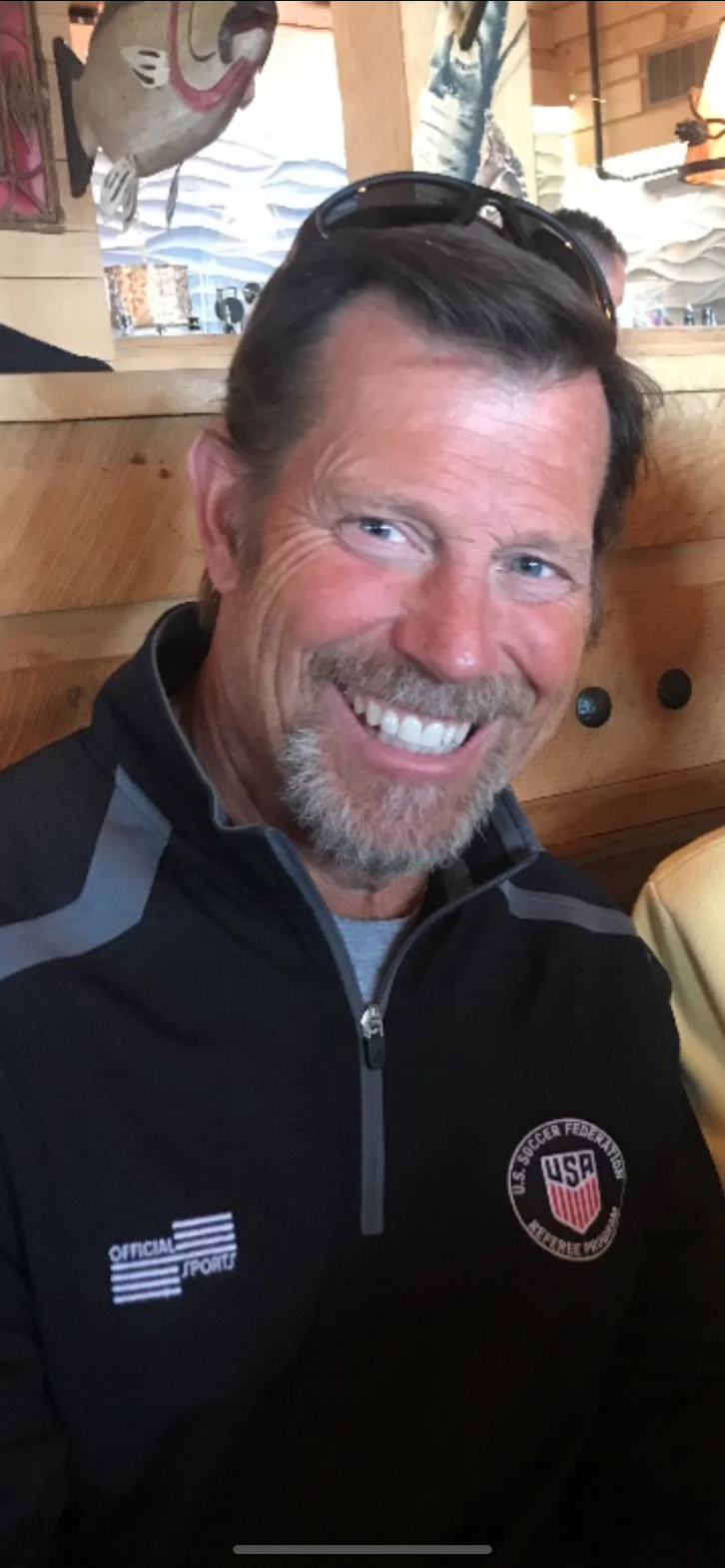
No Comments
Sorry, the comment form is closed at this time.